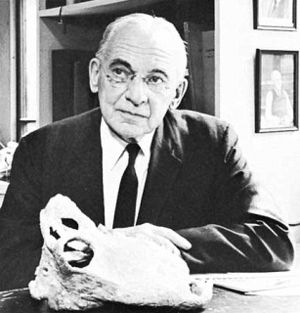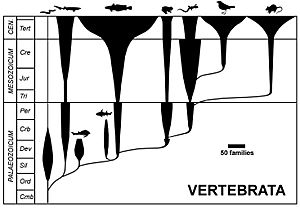Alfred Romer facts for kids
Quick facts for kids
Alfred Romer
|
|
|---|---|

Alfred Romer in 1965
|
|
| Born |
Alfred Sherwood Romer
December 28, 1894 White Plains, New York
|
| Died | November 5, 1973 (age 78) |
| Alma mater |
|
| Awards |
|
| Scientific career | |
| Fields | Paleontology |
| Institutions | Museum of Comparative Zoology |
| Thesis | The Locomotor Apparatus of Certain Primitive and Mammal-like Reptiles (1922) |
| Doctoral advisor | William King Gregory |
Alfred Sherwood Romer (born December 28, 1894 – died November 5, 1973) was an American scientist. He was a paleontologist (someone who studies fossils) and a biologist (someone who studies living things). He was an expert in how vertebrates (animals with backbones) have changed over time.
Contents
About Alfred Romer
Alfred Romer was born in White Plains, New York, in 1894. His parents were Harry Houston Romer and Evalyn Sherwood. He went to White Plains High School.
He studied at Amherst College and earned a degree in biology. Then, he went to Columbia University for his master's and doctorate degrees in zoology (the study of animals). He finished his studies in 1921.
In 1923, Romer became a professor at the University of Chicago. He taught and did a lot of research there. He collected many important fossils from the Paleozoic Era for the Walker Museum of Paleontology.
Later, in 1934, he became a biology professor at Harvard University. In 1946, he took on a big role as the director of Harvard's Museum of Comparative Zoology (MCZ).
Romer was recognized for his work. He was elected to the American Academy of Arts and Sciences in 1937. In 1951, he joined the American Philosophical Society. He also received several important awards for his contributions to science.
How Animals Evolved
Alfred Romer was very interested in how vertebrates (animals with backbones) evolved. He looked at information from different areas:
- Paleontology: The study of fossils.
- Comparative anatomy: Comparing the body structures of different animals.
- Embryology: The study of how embryos develop.
By combining these, he taught about the big changes that happened as fish evolved into the first land animals. These land animals then evolved into all other tetrapods (four-limbed vertebrates). He always stressed how an animal's shape and how it works were connected to its environment.
Romer's Classification of Vertebrates
Romer wrote an important textbook called Vertebrate Paleontology. This book helped organize how vertebrates are classified. Before his book, information about different vertebrate groups was spread out. Romer brought it all together into one clear system.
He also reorganized the labyrinthodontians, which were early amphibians. Many scientists, like Robert L. Carroll, have followed Romer's classification system. It is still used today.
Things Named After Romer
Many things in science are named in honor of Alfred Romer.
Animal Names
Some animal groups and species are named after him:
- Romeriida: This is a group of animals that includes diapsids (like reptiles and birds) and their closest relatives.
- Romeria: This is a genus (a group of species) of early captorhinids, which were small, lizard-like reptiles.
- Romeriscus: This is an early fossil genus. It was first thought to be the oldest known amniote (an animal that lays eggs on land). However, later studies showed it's just a very early Tetrapoda (four-limbed animal).
- Dromomeron romeri: This is a species of an animal related to dinosaurs, named in 2007. The name Dromomeron means 'running femur'. The species name romeri honors Alfred Romer. Finding these fossils showed that dinosaurs and their relatives lived together for a very long time.
Romer's Gap
Romer was the first to notice a missing part in the fossil record. This gap is between the tetrapods (four-limbed animals) from the Devonian period and those from the later Carboniferous period. This missing time in the fossil record has been called Romer's gap since 1995.
Romerogram
A romerogram is a special type of diagram that Alfred Romer helped make popular. It is also called a spindle diagram or bubble diagram.
This diagram shows how diverse (how many different types) a group of animals was over geological time. The vertical axis shows time, and the horizontal width shows how many different groups (like families) existed at that time. This helps scientists see how animal groups changed in number over millions of years.
Books by Alfred Romer
- Romer, A.S. 1933. Vertebrate Paleontology. (Updated in 1945 and 1966)
- Romer, A.S. 1933. Man and the Vertebrates. (Later updated and renamed The Vertebrate Story in 1949)
- Romer, A.S. 1949. The Vertebrate Body. (Updated in 1955, 1962, and 1970)
- Romer, A.S. 1949. The Vertebrate Story. (This was the 4th edition of Man and the Vertebrates)
- Romer, A.S. 1956. Osteology of the Reptiles.
- Romer, A.S. 1968. Notes and Comments on Vertebrate Paleontology.
- Romer, A.S. & T.S. Parsons. 1977. The Vertebrate Body. 5th ed. (6th ed. 1985)


